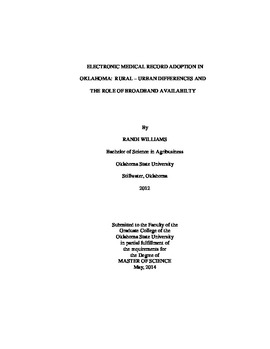| dc.contributor.advisor | Whitacre, Brian E. | |
| dc.contributor.author | Williams, Randi | |
| dc.date.accessioned | 2015-06-17T20:08:38Z | |
| dc.date.available | 2015-06-17T20:08:38Z | |
| dc.date.issued | 2014-05-01 | |
| dc.identifier.uri | https://hdl.handle.net/11244/15191 | |
| dc.description.abstract | Electronic medical records (EMRs) are an important part of the healthcare industry, providing legible and organized patient information along with the potential to reduce healthcare costs and improve health outcomes. However, physicians are still hesitant to adopt. As of 2011, the national EMR adoption rate was only 54 percent - exactly the rate seen in Oklahoma. This study specifically focuses on EMR adoption in Oklahoma. The purpose is to determine the characteristics that influence EMR adoption over time, how those vary across rural/urban locations, and explore the role of broadband availability. Broadband is required for EMR systems to interact with each other, which is an important part of the national "Meaningful Use" criteria. Logistic regressions were run with data from 2800 unique physician offices and the National Broadband Map to accomplish these goals. The data was meshed together to determine the number of broadband providers and average upload/download speeds available to each physician office. This is one of the first studies to explicitly look at the relationship between EMR adoption and broadband availability. The Federal Communications Commission created a pilot program, the Healthcare Connect Fund (HCCF), in late 2012 to expand broadband to healthcare providers - especially those in rural areas. Oklahoma also has a Regional Extension Center (REC) which assists physicians in the EMR adoption process. This research will provide evidence from Oklahoma related to the premise of the HCCF - that certain levels of broadband are needed for effective healthcare; and also provide policy suggestions to increase EMR adoption for Oklahoma's REC. The results demonstrate that the determinants of adoption do vary between rural and urban practices. However, the results also indicate there is no statistical relationship between EMR adoption and broadband availability. Therefore, targeted policies may be important for increasing EMR adoption, but focusing on broadband availability is likely misguided. | |
| dc.format | application/pdf | |
| dc.language | en_US | |
| dc.publisher | Oklahoma State University | |
| dc.rights | Copyright is held by the author who has granted the Oklahoma State University Library the non-exclusive right to share this material in its institutional repository. Contact Digital Library Services at lib-dls@okstate.edu or 405-744-9161 for the permission policy on the use, reproduction or distribution of this material. | |
| dc.title | Electronic Medical Record Adoption in Oklahoma: Rural-urban Differences and the Role of Broadband Availability | |
| dc.type | text | |
| dc.contributor.committeeMember | Shideler, David W. | |
| dc.contributor.committeeMember | Williams, Joseph E. | |
| osu.filename | Williams_okstate_0664M_13240.pdf | |
| osu.accesstype | Open Access | |
| dc.description.department | Agricultural Economics | |
| dc.type.genre | Thesis | |
| dc.subject.keywords | broadband | |
| dc.subject.keywords | electronic medical records | |
| dc.subject.keywords | rural | |
